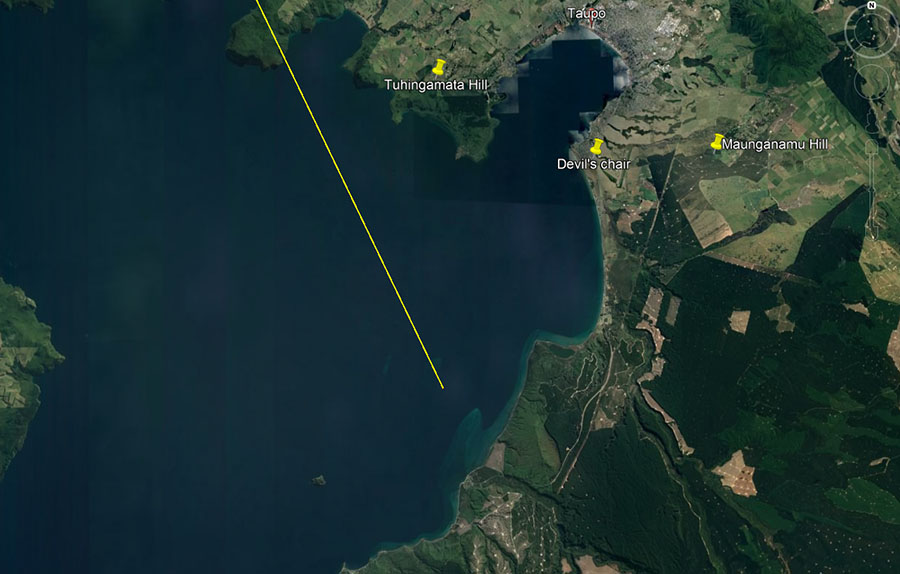

The line running from Pukemore Hill to Taupo enters the lake midway on the northern shoreline but then runs to the east of Motutaiko Island. It’s probable that the island represented, symbolically at least, the resolving point for the SSE running dissecting alignment through the North Island.
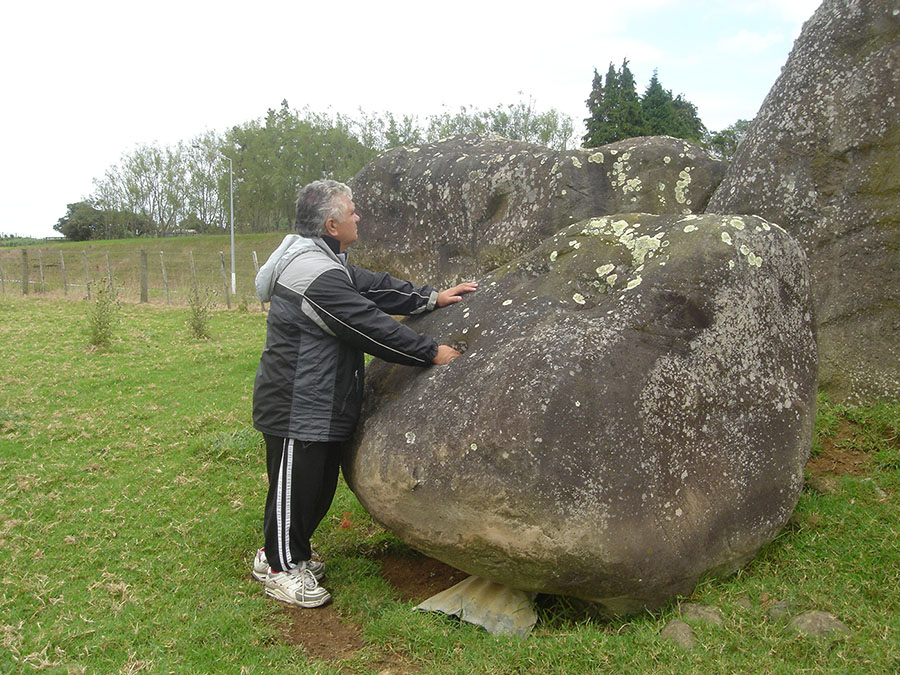
Graham Tatana, a learned elder of Ngati Kuri iwi (tribe) inspecting bullaun bowls at a site near Mount William. His people used to protect remnant Patu-paiarehe/ Turehu from marauding Maori hunters entering Ngati-Kuri’s tribal lands. After catching fish in the harbour, his people would portion out a percentage for the Turehu who could no longer risk going fishing. Graham said that the Maori term, Patu-paiarehe meant: ‘the people you hunt and kill’.
A “patu” is a club, and these were much used in hand-to-hand combat in intertribal fighting.
The bullaun boulder Graham is inspecting has five hewn out bowls in it and, in Ireland, would be recognised as a Neolithic Age blessing and cursing altar.
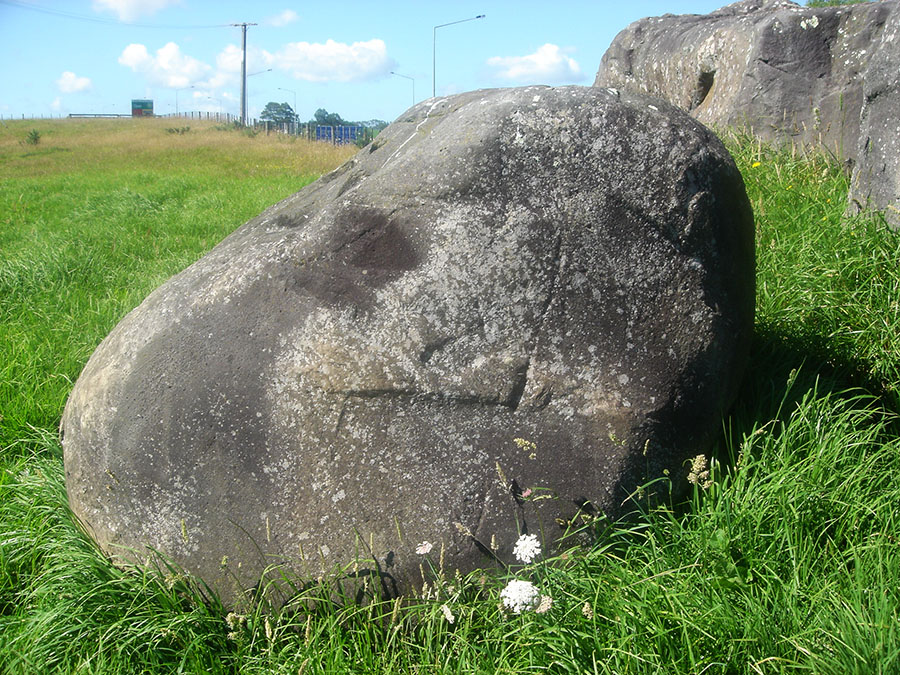
In different light conditions the boulder is seen to have a shaved section in bas-relief and a section in raised-relief, forming a distinct chevron. On the boulder there are two carved chevrons that become prominent at certain angles of the sun.
At the same obelisk site, which was underground until 1992, is a deeply incised, layered-spiral design, on a huge obelisk estimated to weigh in excess of 50-tons:
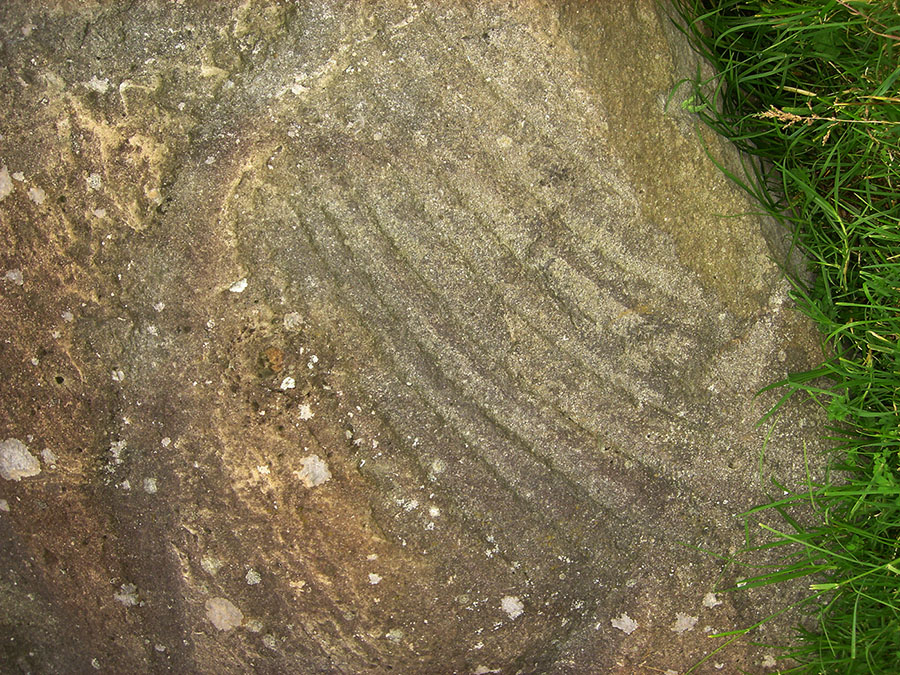
The site with bullaun bowls for a blessing and cursing altar, bas & raised-relief chevrons for shadow play, a layered-spiral, a serpent like bas-relief design and an incised boulder that seemed to convey a direction for the benefit of the wayfarer, was seemingly shaken down by the 186 AD volcanic explosion at Taupo. When excavated during road works in 1992 it was found to have tephra (volcanic ash) from the Taupo eruption covering it. Whoever created these bullauns and designs did so before 186 AD, over 1000-years before Polynesian-Melanesian Maori arrived in New Zealand.
So much more could be said about multiple other sites around New Zealand, but suffice it to say that Maori culture is, for the most-part, Patu-paiarehe in origin.
Researchers like Thor Heyerdahl noted:
'Irrespective of how and when the Maori began to cover their carvings with spirals, the habit is absent in their Polynesian homeland and may therefore very well be so in their still earlier fatherland further away. There is, indeed, no such curvilinear surface design on the wood carvings of the Society Islands and these include the very tall ancestral posts which were erected in ancient Tahiti.'(See: American Indians in the Pacific, pg. 116).
Others have commented similarly about the problem. To accept the official version or explanations concerning the development and attributes of Maori culture, one would have to admit that it sprang-forth as a whole new culture overnight, in a multitude of categories, which had never been exhibited before in island homelands of origin.
At the same time, Maori cultural symbolism does exhibit the foundation elements that have defined Continental European-Mediterranean & British culture for the past 7000-years or more.
Here are a few examples:

Left: The ancient people of the British Isles and greater Europe were advanced artisans in the fabrication and fine polishing of hard stone tools.
Right: They excelled in the cutting, shaping and polishing of very hard jade-stone, which they also venerated as a treasure or article of prestige and high office.
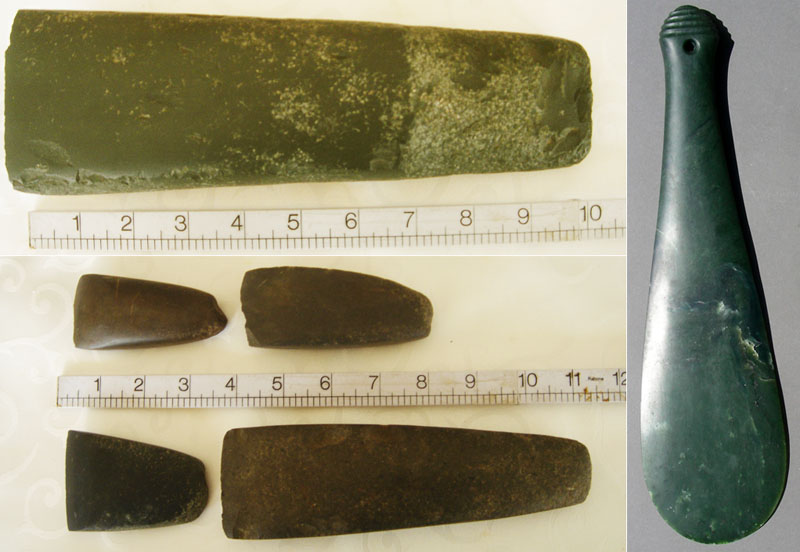
The early Neolithic voyagers ranging across the the length & breadth of the Pacific Ocean brought their adze and stone tool making expertise with them, including the advanced art of fabricating a wide variety of beautiful objects in very hard New Zealand greenstone, which they venerated as a treasure or article of prestige and high office. The greenstone club shown is of the same design as some found in Peru, South America, where upwards of 10,000 very ancient Caucasoid-European mummies, with red or blond hair, etc., have been exhumed so far.
Don Mariano Edward Rivbro (Director of the National Museum of Peru) and Juan Diego de Tschudi (Member of various scientific societies in Europe and America) wrote the book Antigüedades Peruanas (Peruvian Antiquities) in 1850, and stated:
'It is worthy of note that among the clubs there was one, the form of which is completely identical with that which is used by the inhabitants of New Zealand and other islands of the Pacific' (See: Peruvian Antiquities, page 212).
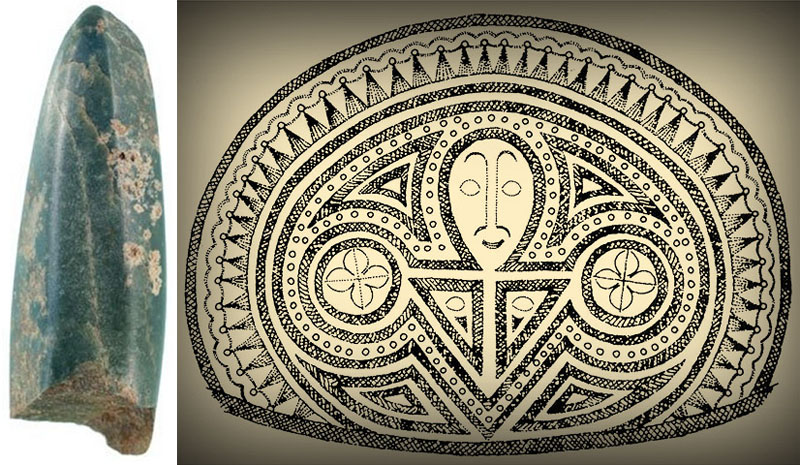
One jadeitite wood-gouge recently discovered on a coral island in Papua, New Guinea has been dated at 3300-years old and the only known region where jadeitite specimens are found to contain similar chemical properties is in Baja California Sur, Mexico. The artefact is attributed to the Lapita people, who ranged through the Pacific Ocean for millennia before the epoch of the Polynesians.
The Lapita people created ornately designed pots, covered in knop, chevron, lozenge and double spiral features which duplicated designs on the kerbstones of Knowth, Newgrange & Dowth chambered mounds in Ireland or patterns found on Wessex pots of ancient England. The above design from a Lapita pot shows a Lapita face, encompassed by an Egyptian Ankh cross. The face is long, with wide eyes, small mouth clench, and a leptorrhine nose, beneath which is a moustache ... all European or Caucasoid features.
It wouldn't be much of a stretch of the imagination to assume that 4-leaf shamrocks (4-leaf clovers) are being displayed on either side of the above figure. The 4-leaf shamrock was much revered by the later Druids and considered to be a source of protection or to have magical properties for clairvoyance.
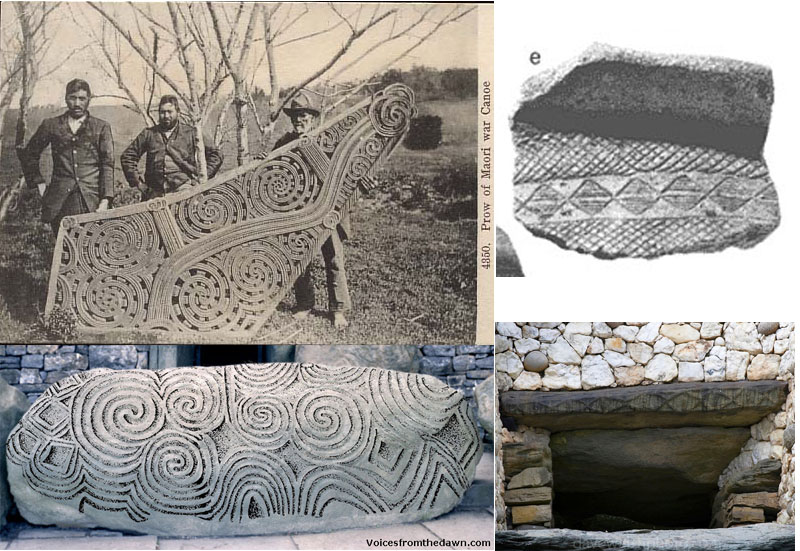
Ornately carved spirals adorn a carved prow from a Maori war canoe. Beneath it is shown the same kinds of double, returning spiral designs carved into a Knowth chambered mound boulder, but dating to about 3150 BC. Also, chevron and lozenge patterns are very prominently used in cultural symbolism throughout Polynesia (Tapa cloths) and, especially, New Zealand. To the upper right is seen a lozenge string on a fragment of Lapita pottery. Below it is seen the window lintel at Newgrange chambered mound, adorned with the same kind of lozenge string.
The Lapita skeletons, when found, just like the ancient, pre-Maori skeletons that were once abundant in New Zealand burial caves or sand-dunes, are not allowed to be studied or forensically tested.
Here’s a quote about this dilemma:
'Unable to research genetic variations in ancient people, she turned to the next best thing - rats. Matisoo-Smith and a colleague, J.H. Robins, examined the variations in mitochondrial DNA of ancient and modern samples of a rat species, Rattus exulans, from Bougainville, New Britain and other Polynesian islands. This species was used as food by the Lapita people in their outrigger canoes when they settled parts of Oceania roughly 3,000 years ago... Ancient human remains in the Pacific are rare and off-limits for study, Matisoo-Smith said, so there was no hope of comparing genetic variations in old and new human tissue'. (See: New Zealand Herald, 26/6/2004).
Similarly, when a complete, very tall, Lapita skeleton was found in 2002, this was the politically-correct result:
"Patrick Nunn, the supervisor of the archaeological team analysing the remains at USP would not comment and said on Sunday "we have decided to keep our find under wraps". 14 July 2002.
THE CAUCASOID EUROPEAN STATUES OF EASTER ISLAND.
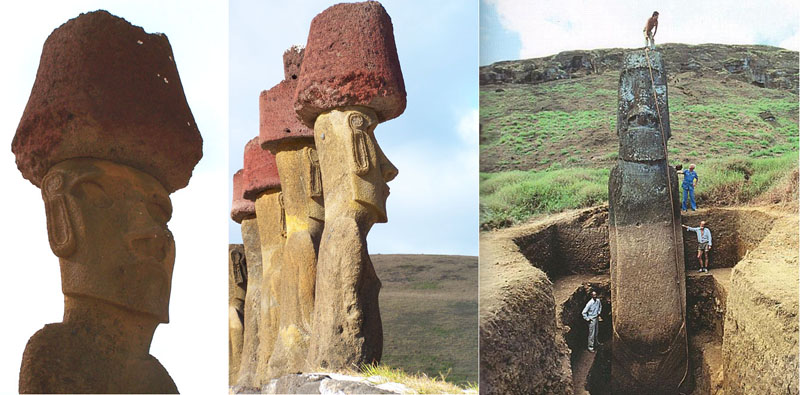
The long thin faces of Caucasoid Europeans with the dolichocephalic cranial (cephalic) index, narrow beaked leptorrhine nose type, wide eyes, thin lips, small mouth clench and prominent chin (the sharpened edge aspect to indicate a full beard) without any indication of chin prognathism.
The jaw line on the lower border of the mandible is very flat or curves slightly upwards, consistent with a European jaw, whereas the Polynesians predominantly display the "Rocker Jaw", with its continuous, pronounced downward curve on the lower border. The "Rocker Jaw" is the single most important identifying feature of Polynesian physiology, occurring in up to 92% of cases. It's incidence at Easter Island amongst the native population is the lowest in Polynesia, showing that there was an early era admixture of a distinctly different racial type that came into the local Polynesian gene pool. This occurred long before modern day explorers found Easter Island in the 1700's and relates to early intermingling with the white, long-eared people encountered when the first Polynesians arrived.
The stone chosen to form the body of each statue on this ahu platform set is a tawny or very light tan colour, consistent with European skin colouration in sunny conditions. The question goes begging: Why would Polynesians laboriously carve and erect many hundreds of huge, hefty statues displaying physiological features of an altogether different racial-type, which bore no resemblance to their own people or revered ancestors? Why would they go to such trouble to make sure that each ancestor had "red hair" top-knots (hair pulled together and knotted) by quarrying that special coloured lava stone (red volcanic ash or tufa) from one isolated location (Teraai Hills) on the island. Some top-knots alone weighed 20-tons and have been transported to the most extreme coastal positions of the island to adorn the statues they were carved for.
To the right is seen just how much silt build-up has occurred since the statues were first placed upon their foundations, and yet we are supposed to believe that these many hundreds of statues were laboriously quarried and shaped by Polynesians, transported overland for several miles and stood up on their platforms as little as 1200-1500-years ago.
A New Zealander looking at the kerbstone art of Knowth, Newgrange & Dowth, etc., would immediately recognise it as duplicating, what is regionally called at the base of the South Pacific, Maori cultural symbolism.
IRISH BULLAUN BOWLS OF THE SOUTH PACIFIC.
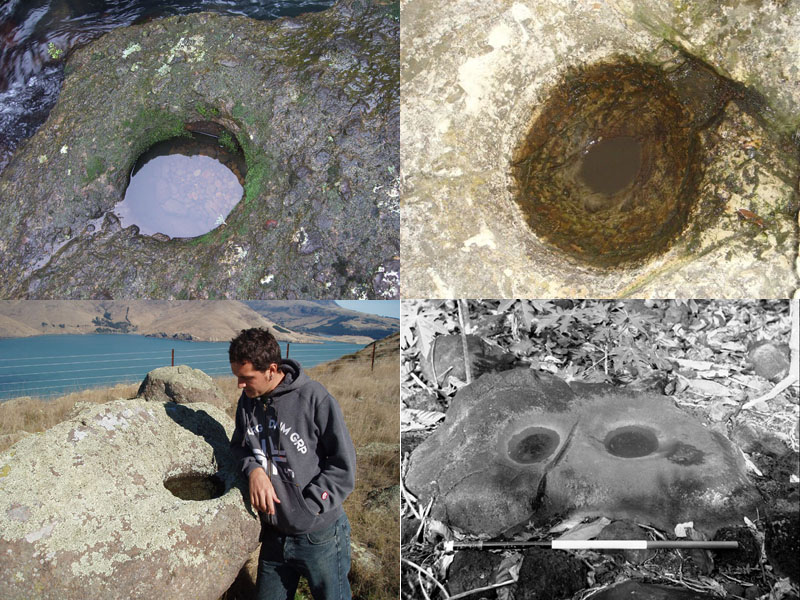
Another of many very ancient and reasonably exclusive cultural idiosyncrasies, brought to New Zealand from the Northern Hemisphere, is laboriously hewn-out bullaun boulders to form blessing and cursing altars. These self-same bullaun altars are found all over Ireland and, to a much lesser degree, in other parts of the British Isles and Continental Europe. In essence, bullaun bowls are a very Irish ritual expression.
The bullaun bowls displayed in the above pictures are from New Zealand, except the one at the bottom right, which is in Samoa. Bullauns, like these, are found throughout New Zealand in both the North and South Islands.

Here are a couple of examples of the bullaun bowls that are found all over Ireland, which were formerly for prayers, ritual washing, blessing & cursing by ancient Neolithic peoples until well into the Christian era. The Pagan use of bullauns merged into Christian usage and the church adopted them, at some point, as baptismal fonts and receptacles of holy water.
And the line-up of evidence goes on & on interminably, but suffice it to say that Maori oral traditions clearly state that, upon arrival in New Zealand, it was found that there was a large, well-established population already living in the country. The inhabitants were described as having skin complexion that was white to light-ruddy, with eye colours from blue to green to darker tints. Their hair colours ranged from white, blond, red, brown & black, with red being predominant in the general population.
Here's a quote:
“The Maoris used to pay great respect to the bones of their dead, yet here and there may be found among sandhills, etc., human remains uncovered by the wind, and of these no tradition remains, as there would certainly be if the relics were those of ancestors. The natives say, “These are the bones of strangers.” So also mortuary-caves are found concerning the contents of which the Maoris make the same remark, and regard them with indifference” (See: The Maori Race, by Edward Tregear, pp. 562-563).
These ancient New Zealanders set up standing stone circles, solar observatories, trig mounds on hill ranges, obelisk survey markers, hill-forts built in the pre-Celtic palisaded style, defensive enclosures riddled with souterrain tunnel systems, souterrain houses, gable-roofed houses, stone beehive houses, canal systems, vast networks of overland walkway systems, irrigation systems, bullaun altars, etc., etc., all of which later came into the possession of Maori as the spoils of conquest.
In the early centuries after the arrival of the Polynesian-Maori, these more ancient inhabitants, who had occupied New Zealand for thousands of years, taught Maori such things as fish-net making, line-dancing, the art of facial tattooing, wood carving in the archaic styles of the Mediterranean, Continental Europe and the British Isles, as well as many forms of arts, crafts, weaving, games, oratory, music, fishing by the moon, etc., etc.
And, of course, they brought their gods, including Taranis (rendered locally using the Scottish derivation Taranaich) in whose honour they aptly named a majestic, active volcano, Taranaki.
In the regional vernacular or dialect evolving in isolation, all words had to end with a vowel, hence Taranaich was rendered Taranaki and an ancient totem bearing his lightning bolt, double-spirals and thunder wheel-cross or sun-cross is preserved in a New Zealand museum.
However, in New Zealand academic circles, these ancient people are not allowed to be remembered and considerable effort is made to expunge them from memory and history.
Martin Doutré, 5/4/18 ©